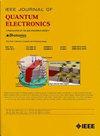Non-Central Phase Matching Second Harmonic Generation by Using High Power Femtosecond Ytterbium-Doped Fiber Laser
IF 2.2
3区 工程技术
Q3 ENGINEERING, ELECTRICAL & ELECTRONIC
引用次数: 0
Abstract
Femtosecond laser has unique advantages in frequency conversion owing to broadband spectrum and ultra-high peak power. Here, the authors demonstrate the non-central phase matching second harmonic (SH) process by utilizing femtosecond ytterbium-doped fiber (YDF) laser. Numerical solution of the coupled wave equations for the process of femtosecond pulses SH indicates that the non-central phase matching is determined by the spectral broadening and frequency shift. Pumped by Watt-level 1040 nm femtosecond pluses, the period quasi-phase matching at the 1064 nm wavelength, the fundamental frequency (FF) spectrum broadened up to 34.7 nm width and red shifted about 6 nm, and the non-central phase matching SH with PPKTP crystal waveguide generates at around 523 nm. The experimental measurements confirm the theoretical predictions, and offer a deeper understanding of nonlinear optical effects. The non-central phase matching enables flexible frequency conversion with potential applications in ultrafast optics.利用高功率飞秒掺镱光纤激光器产生非中心相位匹配二次谐波
飞秒激光具有宽带频谱和超高峰值功率,在频率转换方面具有独特的优势。在此,作者利用飞秒掺镱光纤(YDF)激光器演示了非中心相位匹配二次谐波(SH)过程。飞秒脉冲二次谐波过程的耦合波方程数值解表明,非中心相位匹配是由光谱展宽和频率偏移决定的。在瓦特级 1040 nm 飞秒等离子体的泵浦作用下,1064 nm 波长处的周期准相位匹配、基频(FF)光谱拓宽到 34.7 nm 宽并红移了约 6 nm,而 PPKTP 晶体波导产生的非中心相位匹配 SH 波长在 523 nm 左右。实验测量结果证实了理论预测,并加深了对非线性光学效应的理解。非中心相位匹配实现了灵活的频率转换,有望应用于超快光学领域。
本文章由计算机程序翻译,如有差异,请以英文原文为准。
求助全文
约1分钟内获得全文
求助全文
来源期刊

IEEE Journal of Quantum Electronics
工程技术-工程:电子与电气
CiteScore
4.70
自引率
4.00%
发文量
99
审稿时长
3.0 months
期刊介绍:
The IEEE Journal of Quantum Electronics is dedicated to the publication of manuscripts reporting novel experimental or theoretical results in the broad field of the science and technology of quantum electronics. The Journal comprises original contributions, both regular papers and letters, describing significant advances in the understanding of quantum electronics phenomena or the demonstration of new devices, systems, or applications. Manuscripts reporting new developments in systems and applications must emphasize quantum electronics principles or devices. The scope of JQE encompasses the generation, propagation, detection, and application of coherent electromagnetic radiation having wavelengths below one millimeter (i.e., in the submillimeter, infrared, visible, ultraviolet, etc., regions). Whether the focus of a manuscript is a quantum-electronic device or phenomenon, the critical factor in the editorial review of a manuscript is the potential impact of the results presented on continuing research in the field or on advancing the technological base of quantum electronics.
 求助内容:
求助内容: 应助结果提醒方式:
应助结果提醒方式:


